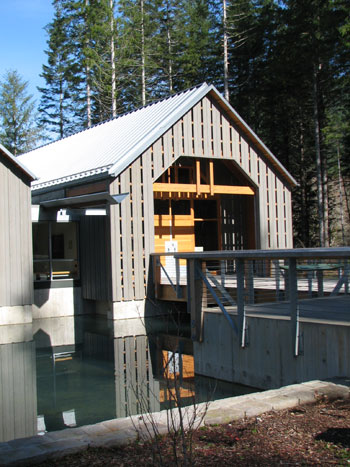
Mention Tillamook Burn today and the image of a charred, grilled cheese sandwich might come to mind. However, seventy-five years ago, it meant one thing: fire.
On a hot, dry day in August, 1933, a wayward spark at a logging site in the Coast Range west of Forest Grove set off an intense inferno. Fueled by strong winds and low humidity, the raging fire burned over 250,000 acres and destroyed 12 billion board feet of prime, old growth, Douglas fir in one week. Smoke darkened the skies from Portland to Astoria, charred needles rained on the coastal town of Tillamook, and ashes fell on decks of ships 500 miles at sea.
The fire set off a six-year jinx with reoccurring fires in 1939, 1945, and 1951. Collectively, they became known as the Tillamook Burn. In 1948, Oregon voters approved $12 million in bonds designated to restore the fire-ravaged forest. These funds initiated one of the largest reforestation projects ever undertaken. For the first time, helicopters were used to drop millions on seeds.
School groups, volunteers, forest workers, and prison inmates planted over 72 million Douglas fir seedlings much to the delight of the local deer and elk population. Burnt wasteland began to transform to a lush, green forest, and in 1973, the area was dedicated and renamed the Tillamook State Forest.
The tragedy of the fire and success story of the reforestation come alive at the newly opened (April, 2006) Tillamook Forest Center on Highway 6 about 50 miles west of Portland and 20 miles east of Tillamook. The Center was funded by the non-profit Tillamook Forest Heritage Trust whose list of donors reads like a who's who of the Pacific Northwest timber industry. Sitting in the middle of a narrow, wooded gorge along the Wilson River, the building used many recycled and green materials and eco-friendly building techniques. For example, the water pond outside collects rainwater to cool the building, flush the toilets, and fill the fire sprinkling system.
A visit to the Center should begin with a viewing of the award-winning film, Legacy of Fire. Through dramatic film footage, photographs, and interviews, it tells the story of the Tillamook Burn in a riveting and fascinating 15 minutes. The theater screen itself is supported by original beams from a burned railroad trestle.
In the museum, interactive exhibits, artifacts, oral-histories, and life-size displays convey the story of the past, present and future of the forest and highlight both the human and natural history of the area. One display, Share Your Memories, provides cards for people to write personal accounts of their experiences with the fire and reforestation.
In the rear of the building, an attractive, 250-foot, pedestrian suspension bridge spans the Wilson River and provides access to a network of hiking trails following the stream in both directions. Next to the bridge, a platform overlooks the river and provides the perfect spot to watch for salmon returning upstream or rafters heading downstream. In the front of the Center, is a replica of a forest fire lookout tower similar to the one that first spotted the fire in 1933. A climb up 72 stairs leads to the top of the 40-foot tower. Interior displays show what life was like for fire spotters in the early 1900s. Viewing the surrounding area from the tower platform makes the transformation from a barren, burnt wasteland 70 years ago to the dense woodlands of today even more dramatic.
The Center, owned and operated by the Oregon Department of Forestry, offers an active program of interpretive events ranging from bluegrass concerts to wildflower walks. The calendar is listed on their web site or call 503-815-6800 for more information.
Easily accessible from Highway 6 and free of charge, the Center makes a worthwhile stop on the way to the ocean or as a day trip destination on its own.
What to bring: If you go in the winter, wear layers and bring a raincoast. In the summer, wear a hat, sunglasses, sunscreen and insect repellant. The center is air conditioned on very hot days. Street shoes or sandlas are fine, but if you're planning to explore the trails bring a good sturdy pair of shoes or boots. Also consider bringing guide books, map, compass, GPS, binocullars, snacks, water bottles and a first aid kit if you are planning to explore the forest.
Tips: There is no cellular phone coverage in the Tillamook Forest area. If you are traveling from Tillamook, consider taking Tillamook County’s public transit service, called The Wave.
Hours: Winter hours are from 10 am to 4 pm, Wednesday through Sunday; in summer, 10:00 am to 6:00 pm daily.
Admission: Free of charge
Directions: From Portland
Approximate driving time one hour.
Travel westbound from Portland on the Sunset Highway (US 26) toward the Oregon Coast. Take Exit 53 marked “Highway 6 | Tillamook | Ocean Beaches” Continue 29.1 miles west on Highway 6. The Tillamook Forest Center is near milepost 22. You’ll see it just past the turn-off for Jones Creek Campground. Look for the large stone and wood entry monuments. You’re here!
From Tillamook
Approximate driving time 20 minutes.
Travel east from Tillamook on Highway 6. After milepost 21 begin watching on your left for the signs for the Tillamook Forest Center. If you pass the turn-off for the Smith Homestead Day Use Area, you’ve gone too far.
By Pat Snider
For Oregon.com